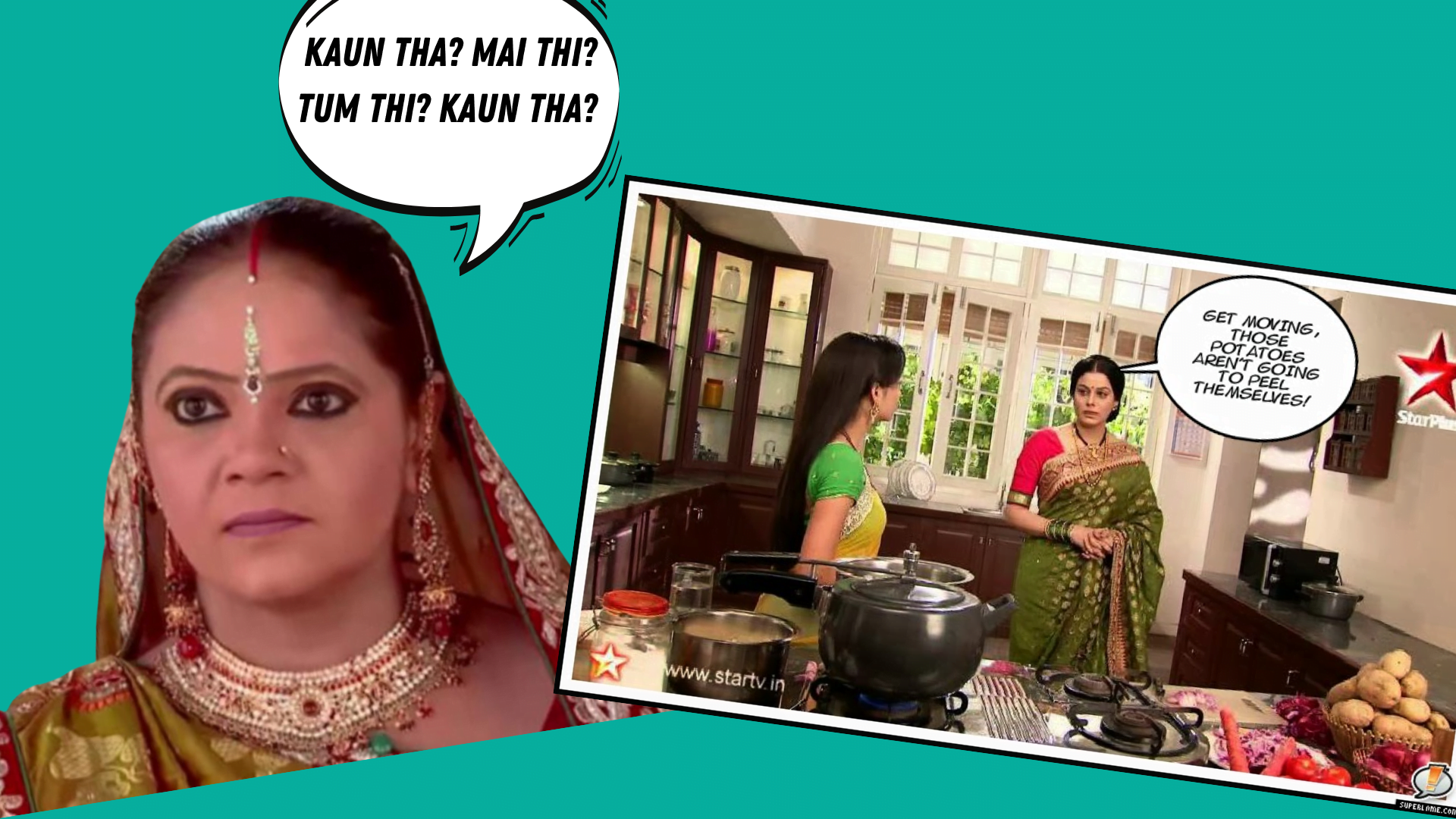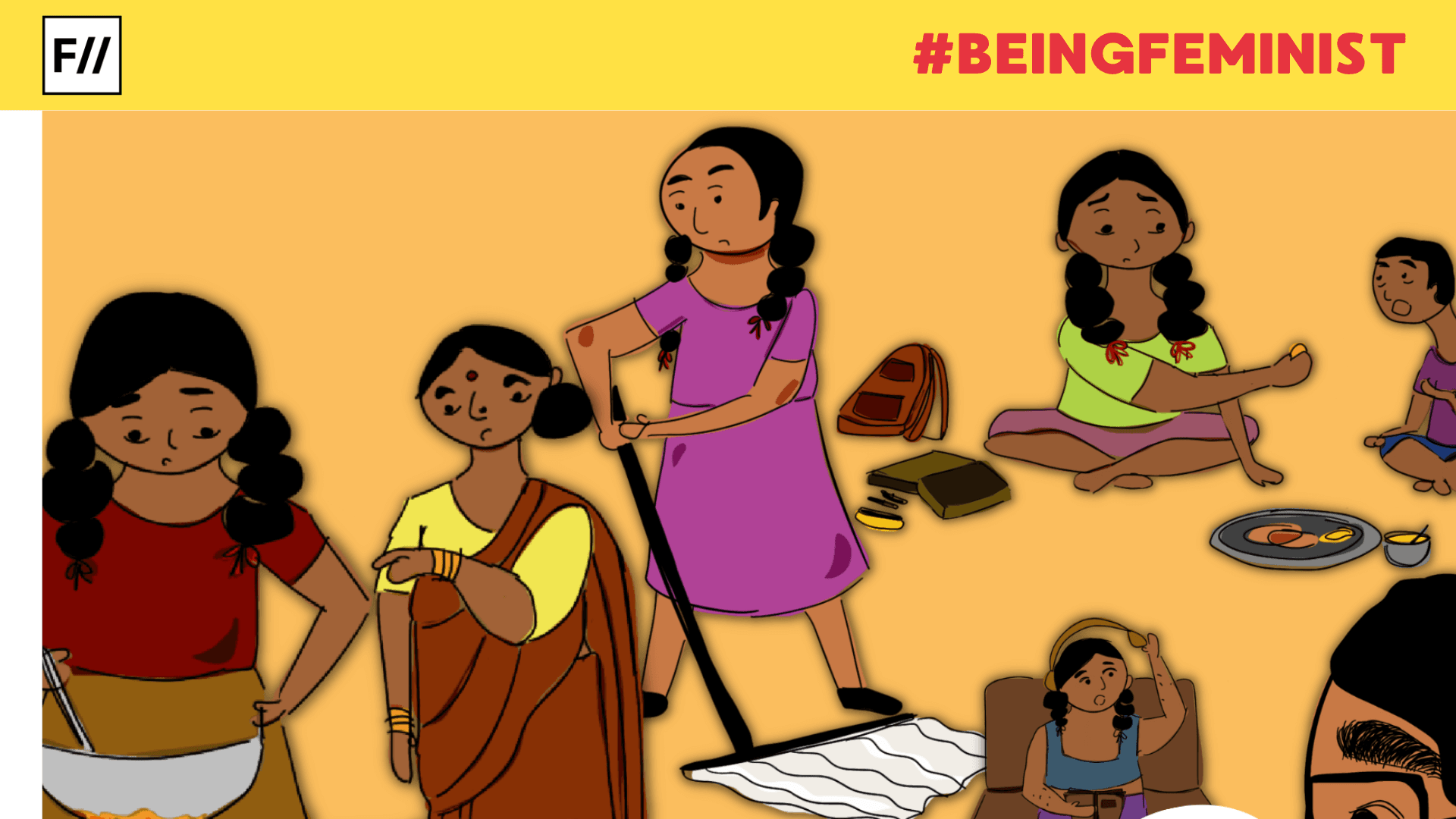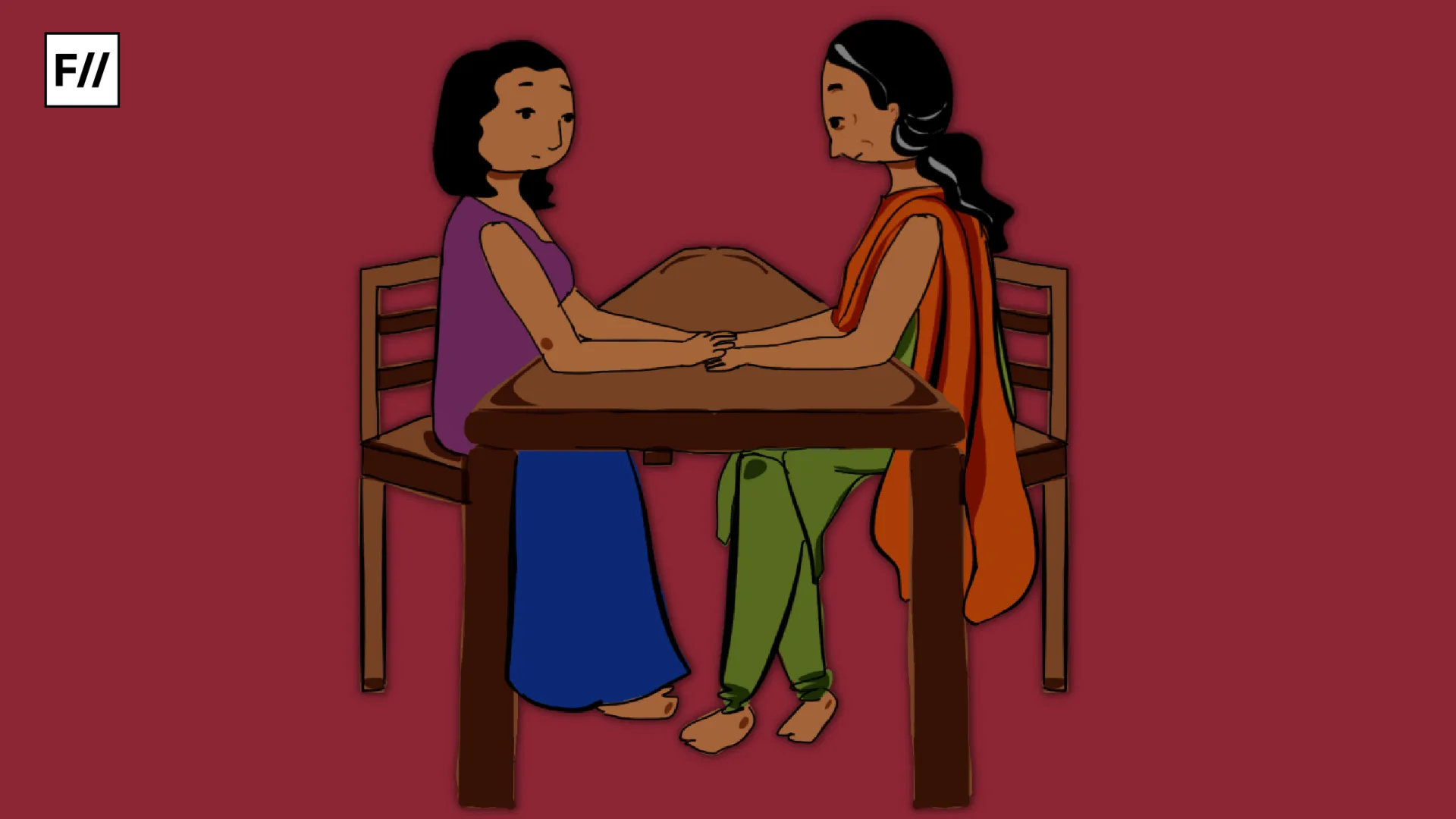Just about a few days ago, music producer Yashraj Mukhate’s Kokila Ben rap had gone viral on social media. The video features dialogues from an Indian television show Saath Nibhaana Saathiya by the popular character Kokila Ben (Rupal Patel), who is seen questioning her daughter-in-law Gopi Bahu (Giaa Manek) about “Rasode mein kaun tha?” (Who was in the kitchen?).
Though the video went viral for its comical representation, the portrayal of saas-bahu (mother-in-law and daughter-in-law) repertoire or of the women performing domestic chores is quite common in Hindi serials. This onscreen representation bears a strong resemblance to the ground reality in India where women spend most of their time performing domestic chores, with the kitchen being at the centre of it.
Through this article, we ask who was in the kitchen: historically tracing how the kitchen has been a site of contention in feminist politics.
Also read: ‘Pay The Bai’: The New Generation Of Men Who Claim To Be Feminists
History of the Kitchen and Food Work
The dynamics of the kitchen and food work is connected to the sexual division of labour. American sociologist and social psychologist Talcott Parsons and Robert F. Bales wrote extensively on the sexual division of labour in their book Family Socialization and Interaction Process.
Sexual division of labour referred to the specialised gender roles of the male breadwinner and the female housewife. This book established that men have an ‘instrumental role’ as the breadwinner and that such a role was considered arduous and stressful, accommodated by the women’s ‘expressive’ role to relieve this burden or tension from the men’s shoulders by providing food, love, and understanding.
This association of women with housework, both structurally and ideologically, was seen as the dominant value system in modern industrialised societies that valued masculine work over feminine work. It is this value system that second-wave feminists such as Simone de Beauvoir, Betty Friedan, Germaine Greer etc. opposed by likening housework to slavery and establishing that the concept of ‘femininity’ results in women’s loss of identity.
This also resulted in many writers blaming feminism for the scarcity of home cooks and the popularity of unhealthy convenience foods whereas, in reality, it was linked to the technological innovations in the early twentieth century. The food industry capitalised on the ‘feminists don’t cook’ stereotype and pushed convenience foods as pro-feminist such as 1970s Kentucky Fried Chicken’s (KFC’s) ad campaign with the slogan, “women’s liberation”.

Despite playing a significant role in problematising naturalised assumptions concerning women, femininity, and domestic roles, second wavers were critiqued for ignoring the complexity of femininity and its intersectionality with race and class.
It was argued that femininity is not a monolithic concept as there are varied experiences such as that of many African-American women who prepared food both in the kitchens of white employers and their own. Researchers like Angela Meah through her work on gender and food has tried to decentre the emphasis on the oppressive nature of the kitchen to focus on the feminist food gaze by including narratives of migrant women.
She states that instead of characterizing the kitchen as a space of silence and subjugation, it can be reclaimed as an opportunity to exercise agency and resistance for women who do not belong to the dominant race or class.
Meredith Abarca also emphasises the reconceptualisation of the kitchen as a space, rather than a place for it to be represented as a site of ever-changing degrees of freedom, self-awareness, subjectivity, and agency. The reconstitution of the kitchen as something more than mandatory labour performed in the service of others is important to fit narratives of non-White women such as the Latin-American and African-American women.
bell hooks in her book Yearning: Race, Gender and Cultural Politics states that her memories of home are the ones where the house belonged to women and cooking was not synonymous with oppression, routine or drudgery, but with an expression of love, nurturance, creativity and sharing, eventually becoming a route to escape the painful realities of racist oppression.
The Kitchen and the Fourth Wave of Feminism
The fourth wave of feminism is different from the previous waves as it acknowledges that the demands of women in different parts of the world are different including those who identify as transgender or non-gender conforming. One of the ways in which the kitchen and food work is being reconceptualised is by looking at it as the ultimate exercise of control over one’s body.
Along with that, the procurement of food provides an opportunity to promote one’s wider ethics such as supporting cruelty-free brands, foods that are environmentally viable etc. While the articulation may be new, the 1980s cookbook, The Political Palate: A Feminist Vegetarian Cookbook was somewhat similar in its sentiments. The book drew similarities between the oppressed women in a patriarchal system and the oppressed animals in a food system.
Comparisons were drawn between men’s control over women’s bodies (their abortions or sterilisations) to raising and killing animals for the mere pleasure of the palate.
Indian Kitchens and the Accidental Kitchen Burns
Closer home in India, the feminist movement, after a post-independence lull, became inclusive as the intersectionality of caste, class, and culture were recognised by the state. The movement entered the private sphere to claim equal rights pertaining to marriage, divorce, succession, sexual violence, and economic opportunities.
With the publication of the ‘Towards Equality’ report in 1974, the gender-discriminatory socio-cultural practices, political, and economic processes were brought to the fore. Similar to the second-wave of feminism in the United States of America, the kitchen was at the centre for Indian feminists as well, but for completely different reasons. Throughout the 1980s, dowry deaths and bride burning were passed off as accidental kitchen deaths.
When it comes to dowry deaths, mothers-in-law are often actively involved in the violence perpetrated against daughters-in-law. This violence is a result of the patriarchal bargain, a term coined by economist Deniz Kandiyoti.
While comparing women’s strategies and coping mechanisms in two different systems of male dominance, she established that women’s strategies change to maximise security and optimise life options in the face of oppression.
Kandiyoti studied two different systems of male dominance; one a modified form of classic patriarchy from Sub-Saharan Africa and the classic patriarchy from Middle-East, South and East Asia.
In classic patriarchy, when a girl is given away in marriage by a male head of the household to another household headed by the husband’s father, she becomes subordinate not only to all the men of another household but also to the more senior women, especially their mother-in-law. The deprivation and hardship that a mother-in-law experiences as a young bride is superseded by the control and authority she eventually has over her own subservient daughters-in-law.
The cyclical nature of women’s power in the household and their anticipation of inheriting the authority of senior women encourages a thorough internalisation of this form of patriarchy by the women themselves (popularly referred to as Kyunki Saas Bhi Kabhi Bahu Thi).
In the Global South, women are characterised as the gatekeepers of the family pantry as they play a significant role in the everyday politics of food allocation within the household. As the food is used as a mechanism to express reward and retribution, the spatial dynamics of food work provides power to the woman that might be invisible to an outsider.
This very power is then used to isolate and seclude the woman, especially the daughter-in-law who is the lowest in the hierarchy of power structure. When the rules of subservience commanded by the in-laws are not conformed to, this kitchen becomes the place where they are punished for their insubordination often by being burnt alive.
The Indian Kitchen and the Interplay of Gender and Caste
Apart from the violent imagery associated with the kitchen, there are other interpretations of Hindu kitchens from a cultural standpoint as well.
In his book The Migrant’s Table: Meals and Memories in Bengali-American Households, Krishnendu Ray writes that invoking tradition in the form of giving Hindu women the responsibility of the transfer of divine beneficence during the offering and blessing of the food and serving it to her family as if she were a priest, can be looked at as a way of keeping women in their ‘place.’ This sentiment has also been resonated by migrant populations where the emphasis is on sustaining the cultural ties instead of achieving gender equality.
These structural frameworks based on religion have provided the basis of subordination of women in Indian society.
When understanding the dynamics of Indian kitchens, it is important to mention the role of caste-system as it plays a very important role in the Indian landscape. In a recent survey conducted by the India Human Development Survey (IHDS-2), 27% of respondents agreed that they did practice untouchability in some form. When asked about untouchability, most of the respondents refused that they practice untouchability but were uncomfortable with a Dalit person entering their kitchen and using their utensils.
In most upper-caste households in India, the person who cleans the washroom cannot cook food, and vice versa, furthering the division of labour along caste lines accompanied with the Brahmanical concept of purity and pollution.
In a recent article on the food of Dalit communities, Vinay Kumar talks about blood fry, a dish prepared by Dalit families with coagulated goat blood which has started to fade away from their kitchens. He states that Dalit food often has shame attached to it which has found no place in food writing.
He cites an example of shame associated with beef, especially after it was banned in India, which brought in violence and lynching along with it. Historically, beef has been consumed by Dalit communities because it was a means of payment for their caste occupation which was to dispose of carcasses.
Unlike food memories for a lot of people that carry memories of love, care, or warmth, Dalit food is a reminder of harsh realities, born out of hunger, poverty and marginalisation. The food culture of Dalit, Bahujan and Adivasi communities has been deeply influenced by the oppression, geography, local species of flora, fauna and animals, and caste hierarchy.
So for Indian (feminist) food studies to be whole, it is imperative that these narratives of resistance and protest are included.
COVID-19 and the Burden of Housework
The idea of men being in the kitchen is not novel to the pandemic but something that second-wave feminists actively advocated. In the 1970s, Irene Peslikis stated that she wanted to write a women’s liberation cook book consisting of easy dinners with directions. The aim of this cookbook was to encourage men to take on more household labour to advance gender equality.
Despite this aspirational equal division of household chores being monetised by brands like Ariel with their #ShareTheLoad campaign, it is only women who are seen cooking, cleaning, and washing in the advertisements varying from oil to kitchen washing soaps.
The Coronavirus pandemic has disrupted the apparatus in Indian homes with discontinuation of part-time help and service providers. Despite men and women both being stranded at home, women are disproportionately facing the burden of domestic chores, which has brought the focus back to men’s involvement in household chores.
In a paper by Ashwini Deshpande on the impact of COVID-19 and lockdown on domestic work in India, she has analysed data of roughly over 40,000 individuals using numbers from the Centre for Monitoring Indian Economy (CMIE) and Consumer Pyramids Household Survey (CPHS).
She found out that the numbers of hours spent on domestic work increased for both men and women during the lockdown but the proportion of men doing housework per day has increased post-lockdown. However, she also stated that it is too early to say whether these shifts are transitory or permanent but the shift seems promising given the highly unequal gender norms in India.
Also read: Indian TV Serials Are Not All About ‘Rasode Mein Kaun Tha?’ Level Drama. No, Really!
What is the Feminist Way to the Kitchen?
There is a certain complexity associated with food work and the kitchen as it consists of tasks associated with planning, purchasing, storing, cooking, and preparing food, as well as related tasks such as washing up and clearing away.
As food work and women’s domestic engagement is not something that directly contributes to the productive economy, it has always been seen as lacking in value. This is why the dominant discourse amongst feminists has remained whether to accept the oppressive character of food work as drudgery or go beyond for a more nuanced understanding of the geographies of domestic power that have reconfigured the kitchen as a site of liberation rather than oppression.
So if the kitchen is the heart of the sacred geography of home, what is then the spatial dynamics of the kitchen: an extension of the holy, a box of oppression, a basic need, or a reclamation?
Do we as women stepping out, then get stopped by the one who continues to protest for us to ‘remain’ in the kitchen? While the question ‘what lies in the kitchen?’ remains, the answer will always be a revolution.
Shivangi Deshwal is a Gender based Violence prevention specialist and a feminist researcher. She is a trained feminist social worker specializing in violence against women intervention and research. She has been associated with RCI-VAW, TISS and PVWC, SNEHA in the past. She can be found on Facebook, Linkedin and Twitter.
Sumati Thusoo is a Research Author at the Department of Sociology at Monk Prayogshala, a not-for-profit research organization based in Mumbai. She is a trained feminist social worker and a development practitioner who has worked in the areas of gender justice, child rights, anti-trafficking and migration. She can be found on Facebook, Twitter and LinkedIn.




